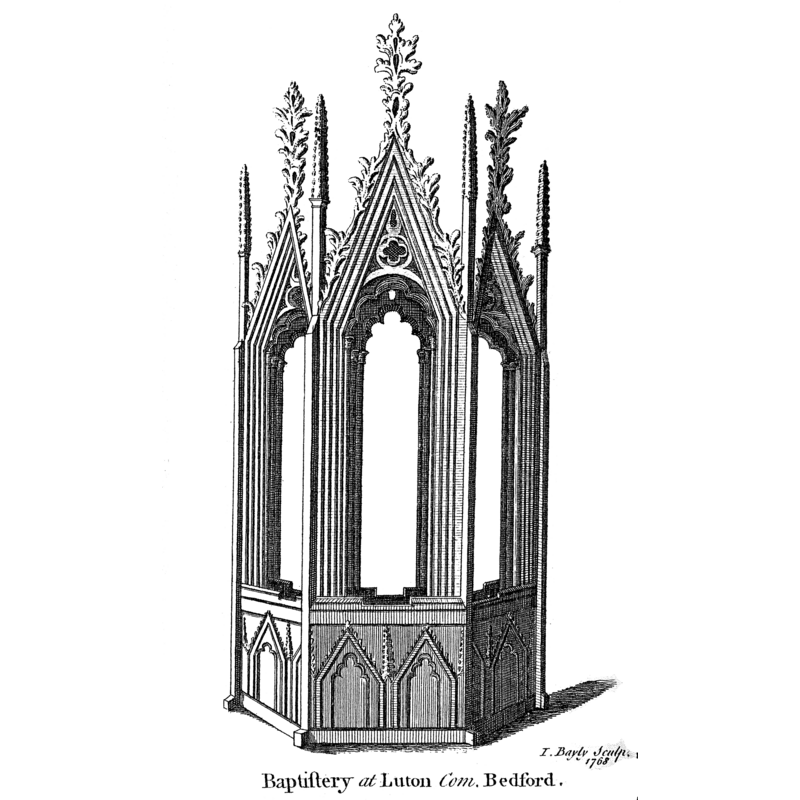Luton / Lectuna / Leweton / Loitone / Lutune / Lygeanburh / Lygetune
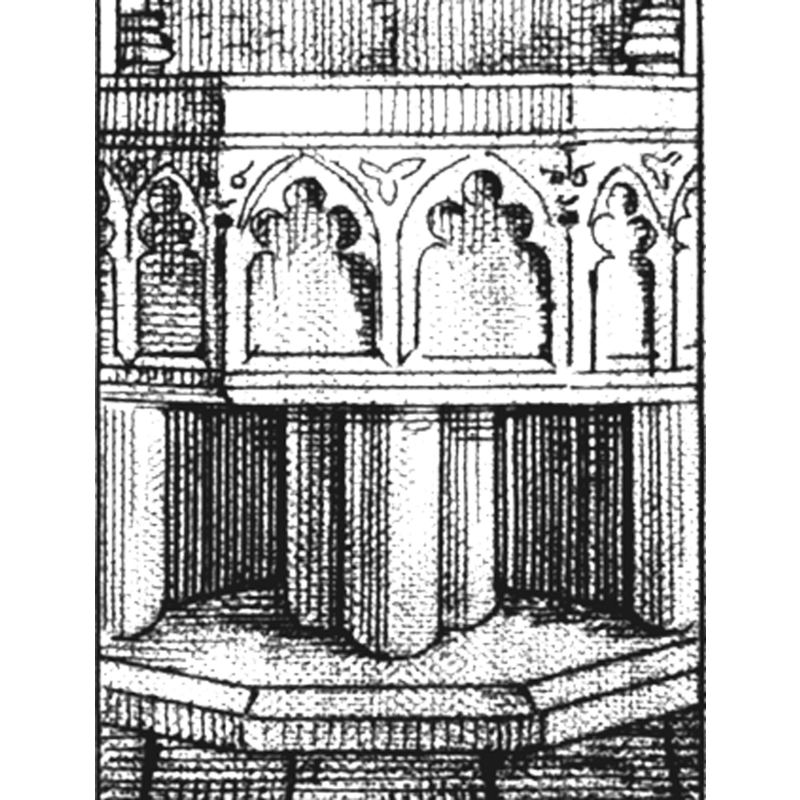
Image copyright © [in the public domain]
PD
Results: 12 records
B01: design element - architectural - arcade - blind - cinquefoiled arches - 16
BS01: head, face or mask - 8
Scene Description: there appear to be masks or faces carved on the upper angles of the basin
Copyright Statement: Image copyright © Greentool2002, 2010
Image Source: detail of a digital photograph taken 12 September 2010 by Greentool2002 [www.flickr.com/photos/greentool2002/4984316148/] [accessed 14 May 2012]
Copyright Instructions: PERMISSION NOT AVAILABLE -- IMAGE NOT FOR PUBLIC USE
BS02: symbol - triquetra or trefoil - 8
Scene Description: on the flat side, alternating with the carved masks or faces on the angles
Copyright Statement: Image copyright © Greentool2002, 2010
Image Source: detail of a digital photograph taken 12 September 2010 by Greentool2002 [www.flickr.com/photos/greentool2002/4984316148/] [accessed 14 May 2012]
Copyright Instructions: PERMISSION NOT AVAILABLE -- IMAGE NOT FOR PUBLIC USE
view of church exterior - northeast view
view of church interior - nave - looking west
Scene Description: the baptismal canopy and font now located at the west end of the nave
Copyright Statement: Image copyright © Basher Eyre, 2011
Image Source: digital photograph taken 8 September 2011 by Basher Eyre [www.geograph.org.uk/photo/2597339] [accessed 14 May 2012]
Copyright Instructions: CC-BY-SA-3.0
view of font
view of font
view of font and canopy, baldachin - canopy
view of font and canopy, baldachin - canopy
view of font and canopy, baldachin - canopy
view of font base
Scene Description: notice the replacement colonnettes of the base; the central shaft is probably original
Copyright Statement: Image copyright © Greentool2002, 2010
Image Source: detail of a digital photograph taken 12 September 2010 by Greentool2002 [www.flickr.com/photos/greentool2002/4984316148/] [accessed 14 May 2012]
Copyright Instructions: PERMISSION NOT AVAILABLE -- IMAGE NOT FOR PUBLIC USE
INFORMATION
FontID: 01070LUT
Object Type: Baptismal Font1
Church/Chapel: Parish Church of St. Mary
Church Patron Saints: St. Mary the Virgin
Church Location: St Mary's Road, Luton LU1 3JE / Church Street, Luton, Bedfordshire, LU1 3JF
Country Name: England
Location: Bedfordshire, East
Directions to Site: Located 8 km E of Dunstable, 28 km S of Bedford, 55 km NW of London on the A6 (M1 exit 10/11)
Ecclesiastic Region: Diocese of St. Albans [formerly in the diocese of Ely]
Historical Region: Hundred of Flitt
Font Location in Church: Inside the church, in the nave, south transept [previously at two other locations - cf. Font notes (Simpson) for details]
Date: ca. 1330-1340?
Century and Period: 14th century (early?), Decorated
Credit and Acknowledgements: We are grateful to the Thomas Fisher Rare Books Library for access to the copy of Lysons’ Magna Britannia, and to Jim Ingram, of the Preservation Services, Robarts Library, for the digital imaging of Lysons’ illustrations.
Church Notes: The church was begun in 13th century, enlarged in the 14th century, and reached its present form in the 15th century. Lord Wenlock build the chapel with open arches over the Wenlock tombs and brasses. The octagonal 14th-century baptistery is a work of craftsmanship. The W tower is an example of the local chequer-board patterning of flint combined with clunch, and later limestone. Street's work in the chancel is sensitive.
Font Notes:
Click to view
An anonymous communication to The Gentleman's Magazine (vol. XLVIII: Nov. 1778) describes the canopy over the font, dating the canopy "about the time of Richard II" [i.e., 1367-1400]; the article points out that a dozen people fit comfortably within, and that "what makes the font extremely remarkable is the singular situation thereof, viz. in the body of the church", as opposed to the more common placement of it in the west end of the nave. Carte (1792) describes the canopy as "a noble and antique structure". Gough (1792) writes: "The font at Luton is octagonal on steps, having over it an octagonal stone canopy, supported by eight pillars, about 25 feet high, and making a small freestone chapel round the font capable of containing seven or eight people with great ease. It may very properly be called a baptistery, and is the only one of the kind perhaps in England [fn1]. In the centre of the roof is a lion O. and a griffin V. rampant. Mr. Blomefield calls it a vine, a dragon, and the holy lamb, which lasts defends the vine from the injury of the dragon, signifying that baptism defends us from the devil, and that, by the assistance of the Lamb of God, the evil one should have no power to hurt the church, of which the vine is an emblem. On the top of all is a large bason, where the consecrated water used to be kept, which was let down out by a pipe at the priest's pleasure into the font [fn2]". Gough (ibid.) further adds the Luton font cover as an instance "of costly and laboured covers, finished in a rich Gothic style of wood-work". Noted in Lysons (1806-1833) as one of a group of octagonal fonts made mostly of Totternhoe stone: "Luton stands on five pillars, and is ornamented with Gothic arches; the font is inclosed [sic] within a baptistry of stone at the west end of the nave, enriched with pinnacles, quatrefoils, and foliage, in the style of the fourteenth century." Although neither Lysons nor any other bibliographic source mention it, there are ornamental details in the spandrels of the arcade around the font sides: triquetra or trefoil, alternating with masks or faces. Simpson (1828) writes: "The Font in this church is not worthy of any other notice, than that it stands on five circular legs which we suppose to be older than the bowl. On the top of it is placed a flat stone on which stands a basin, now used for baptism. But the magnificent baptistery erected over it, is so intimately connected with the class of antiquities of which this work is an attempted illustration, that we have adopted it as a frontispice [in Simpson's book] [...] About 40 years since [i.e., ca. 1788] this splendid fabric stood under the third arch from the west end of the south aisle; it was then moved to the centre of the west end of the nave, where it must have added greatly to the beauty of the church. About six years since it was moved to its present station, viz. the south transept." (ibid.). The crockets on the gables are richly flamboyant. Painted white, they should be coloured and gilded." Noted in Britton's Dictionary of 1838 [after Simpson]. Reported in Lewis' Directory of 1848: stone font supported on five pillars." In Batty (1848). The National Gazetteer of 1868 has: "A beautifully constructed baptismal font, said to be the finest in the kingdom, stands before the west door; in form it is hexagonal, supported upon five pillars, and enclosed in a baptistery, elegant in design and workmanship." A report in The Antiquary (July 1st, 1871, p. 62) on the visit to this church by an excursion of the Bedfordshire Architectural and Archaeological Society describes the canopy structure over the font and notes: "It is said that in former times water was let down from the leads by a pipe to supply the font." The architect G.E. Street refers to the canopy, which he restored, in a letter to the Guardian reproduced in The Architect (issue of 30 August 1873: 101). Bond (1908) describes it as a 14th-century 20ft tall and very rich baldacchino-type stone cover [unfortunately Bond's photograph does not show the font itself]. Rickman & Parker [woodcut by Orlando Jewitt] (1881) describe the "beautiful chapel or baptistery, of very fine composition" and, again, fail to describe or illustrate the font itself. The Victoria County History (Bedford, vol. 2, 1908) notes: "Luton Church is mentioned in Domesday when it was held by William the king's chamberlain, having been held by Morcar the priest during the Confessor's reign [i.e., Edward (1003-1066); reigned 1044-1066]. [...] In spite of much enlargement and rebuilding, enough is left to show that a cruciform church existed here in the twelfth century, and the arches still existing in the west walls of the transepts prove that the nave had north and south aisles by the end of the century, if not earlier. [...] The font has an octagonal bowl with panelled sides and engaged shafts at the angles, standing on an octagonal stem, which is surrounded by smaller shafts, and is apparently of the same date, c. 1330, as the baptistery." Tyrrell-Green (1928) describes it as a baptismal font of the Decorated style with an octagonal basin ornamented with a blind arcade; it is mounted on a pedestal that also has an arcade ornamentation. Tyrrell-Green (ibid.) describes the font 'cover' at Luton as a "stone erection of the like kind [i.e., a tall cover conservative in its general design], surrounding and containing the font, and belonging to the Decorated style." Noted in Pevsner (1968) with date for the font "ca. 1330-40" of a bout the same date as the canpy. Described in Jenkins (1999) as "a superb work of early 14th-century carving with octagonal gabled canopy. The font itself appears now [September 2010] much as it did originally, with the exception of the eight outer colonnettes and the octagonal lower base, which are modern replacements; the central shaft, however, is probably the original one.
COORDINATES
Church Latitude & Longitude Decimal: 51.878695, -0.410221
Church Latitude & Longitude DMS: 51° 52′ 43.3″ N, 0° 24′ 36.8″ W
UTM: 30U 678255 5750717
MEDIUM AND MEASUREMENTS
Material: stone, limestone [chalk / Totternhoe stone?]
Font Shape: octagonal (mounted)
Basin Interior Shape: round
Basin Exterior Shape: octagonal
LID INFORMATION
Date: 14th-15th century?
Material: stone
Notes: Not a font cover but, rather, a gabled canopy that surrounds the font [cf. FontNotes for details]
REFERENCES
"Luton, in Bedfordshire", XLVIII, November 1778, The Gentleman's Magazine: or, Trader's monthly intelligencer, 1778, pp. 505 and pl. on opp. p.; p. 505 and pl. on opp. p.
The National Gazetteer: a Topographical Dictionary of the British Isles, London: Virtue & Co., 1868
Victoria County History [online], University of London, 1993-. Accessed: 2012-05-15 00:00:00. URL: https://www.british-history.ac.uk.
Batty, Robert Eaton, Some particulars connected with the history of baptismal fonts: being a paper read at the quarterly general meeting of the Architectural and Archaeological Society for the County of Buckingham, London: F. & J. Rivington, 1848
Betjeman, John, An American's Guide to English Parish Churches (including the Isle of Man), New York: McDowell, Obolensky, 1958
Bond, Francis, Fonts and Font Covers, London: Waterstone, 1985 c1908
Britton, John, A Dictionary of the Architecture and Archaeology of the Middle Ages, including […], London: Longman, Orne, Brown, Green, and Longmann, Paternoster Row, and the Author, Burton Street, 1838
Carte, Samuel, "Three letters from Mr. Samuel Carte to Dr. Ducarel, and one to Sir Thomas Cave, concerning fonts [or, Mr. Carte's Observations on ancient fonts]", X, Archaeologia, 1792, pp. 208-225; p. 219
Cox, John Charles, English Church Furniture, New York: E.P. Dutton & Co., 1907
Gough, Richard, "Description of the old font in the Church of East Meon, Hampshire, 1789: with some observations on fonts", X, Archaeologia, 1792, pp. 183-209; p. 206 and fn, 207
Jenkins, Simon, England's Thousand Best Churches, London and New York: Allen Lane, the Penguin Press, 1999 [2000 rev. printing]
Knight, Charles, The English Cyclopaedia, London: Bradbury, Evans & Co., 1867
Lewis, Samuel, A Topographical Dictionary of England, Comprising the Several Counties, Cities, Boroughs, Corporate and Market Towns, Parishes, Chapelries, and Townships, and the Islands of Guernsy, Jersey, and Man, with Historical and Statistical Descriptions [...], London: S. Lewis, 1831
Lysons, Daniel, Magna Britannia, being a concise topographical account of the several counties of Great Britain, London: Printed for T. Cadell and W. Davies, 1806-1822
Parker, John Henry, A Glossary of Terms used in Grecian, Roman, Italian and Gothic Architecture, Oxford: J. H. Parker, 1850
Pevsner, Nikolaus, Bedfordshire and the County of Huntingdon and Peterborough, Harmondsworth: Penguin, 1968
Rickman, Thomas, An Attempt to Discriminate the Styles of Architecture in England, from the Conquest to the Reformation, with a Sketch of the Grecian and Roman Orders, An [7th ed. -- orig. published in 1817], Oxford and London: Parker and Co., 1881
Simpson, Francis, A series of ancient baptismal fonts: chronologically arranged, drwan by F. Simpson, Jun., engraved by R. Roberts, London: Septimus Prowett, 1828
Tyrrell-Green, E., Baptismal Fonts Classified and Illustrated, London: Society for Promoting Christian Knowledge: The Macmillan Co., 1928

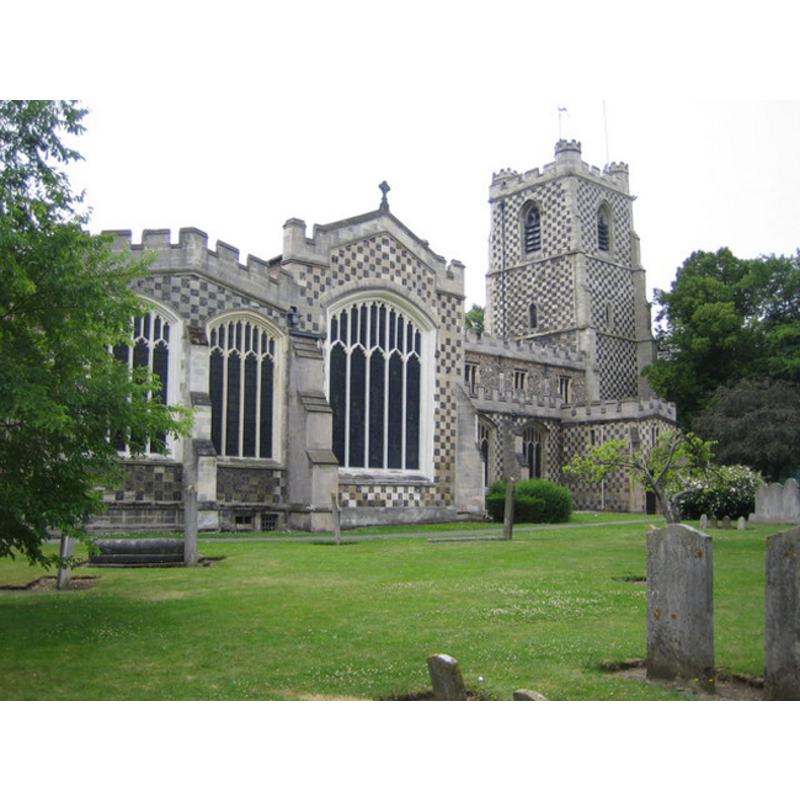
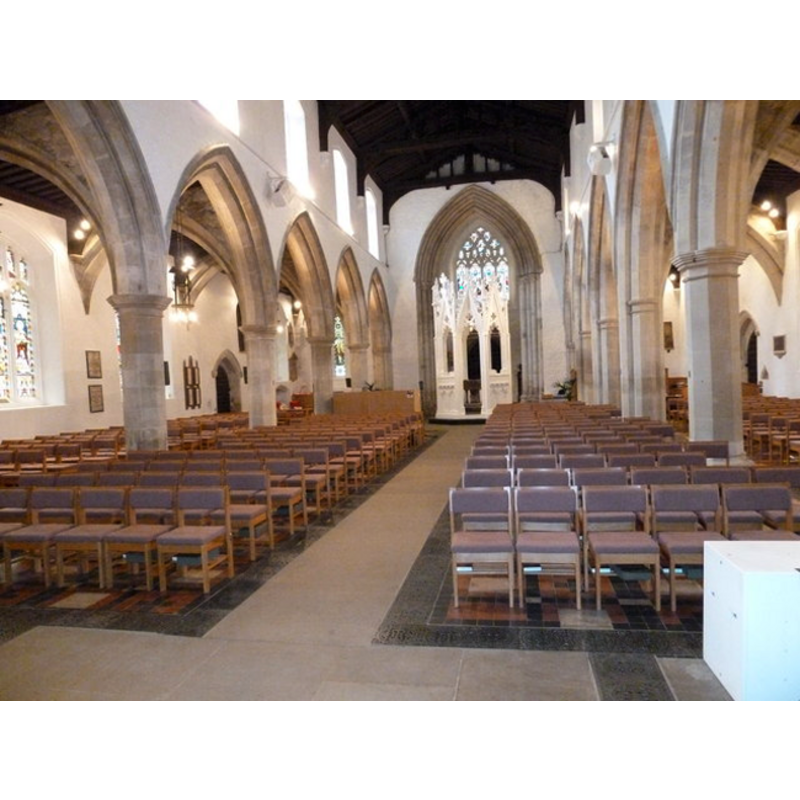
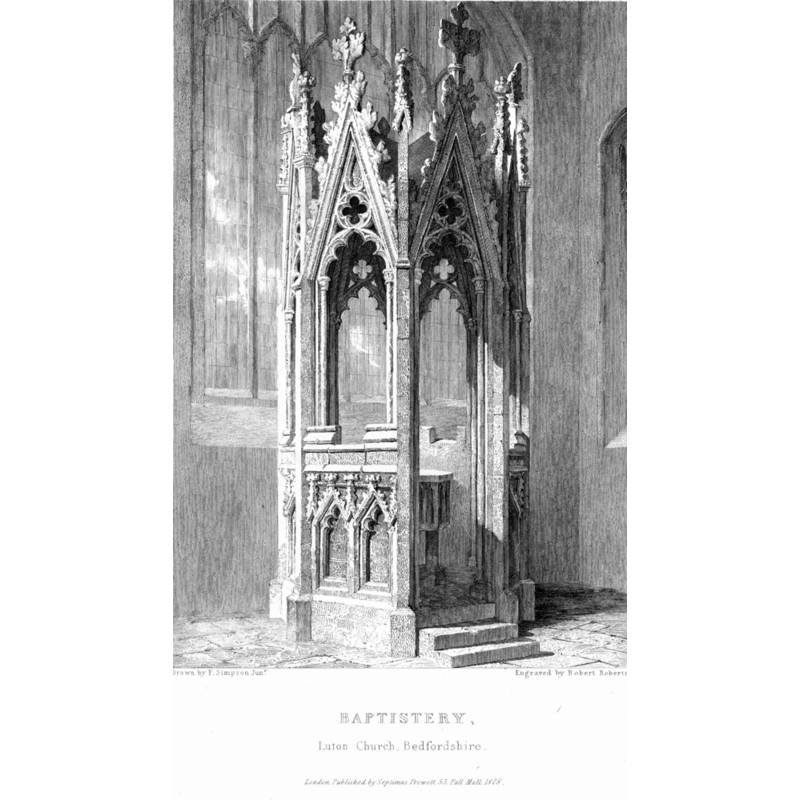
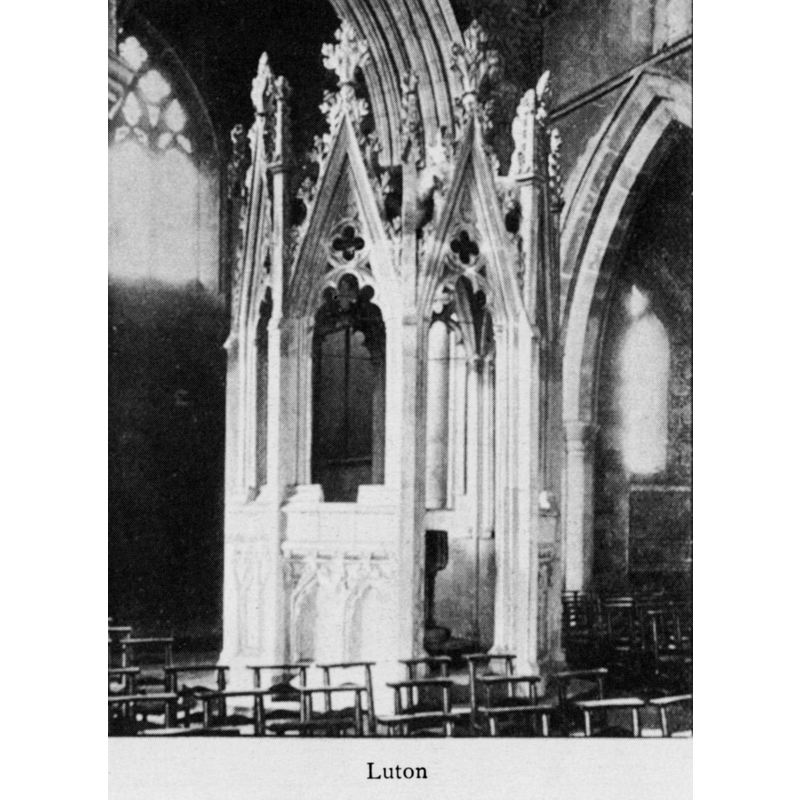
!["S. Lysons delin et fecit [...] published 1 March 1805"](/static-50478a99ec6f36a15d6234548c59f63da52304e5/compressed/1050204015_compressed.png)
